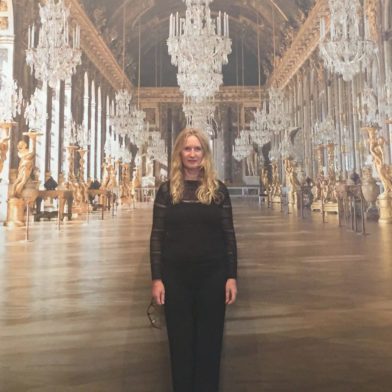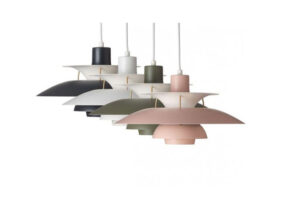Curated by fabulous Australian creatives such as William Smart, Arent&Pyke, Hare+Klein, KPDO, SJB and Habitus’ very own Aleesha Callahan the selections – while all iconic – are each a reflection of the design mind at the heart of the creative.

The Lampe de Marseille, Le Corbusier’s design of 1949 for example, speaks directly to the elegance and conscience we have come to know of Kirsten Stanisich (Richards Stanisich).
“The Nemo Lampe de Marseille light is a wonderful light fixture. It’s mind-blowing to think that it was created almost 75 years ago yet still remains so relevant to our own era of contemporary design. Ironically while Le Corbusier strode to reject previous historical architectural styles in his work it is the heritage value of the fitting that is one of the many beautiful things that we have embraced. Because of this, it has retained a value for re-use to align with current sustainable principles making this piece a true design icon,” says Stanisich.


Selecting the PH5 light designed by Poul Henningsen and manufactured by Louis Poulsen, Adam Haddow, SJB Director says: “The PH5 is to lighting what Madonna is to music – lasting and still innovative.”
Indeed, the exhibition showcases 25 of the world’s most recognisable furniture and lighting designs by Hans Wegner, Arne Jacobsen, Le Corbusier, Verner Panton, Achille Castiglioni and more.


“At Cult we are proud to advocate for authentic design and the value of investing in original design icons. We are passionate about sharing the surprising stories behind the world’s most recognisable design icons and the legendary designers behind them,” shares Richard Munao, Cult Founder and CEO.
Each icon is presented alongside personal anecdotes from the selecting curator. Curators include influential designers from Smart Design Studio, KPDO, Arent&Pyke, Richards Stanisich, Hare+Klein, SJB, Futurespace and Decus; to editors from Yellowtrace, The Design Files, Vogue Living, Habitus, Australian Financial Review, The Local Project and Est Living; to leading stylists Claire Delmar and Megan Morton; fashion designer Lee Mathews, among others prominent influencers in the Australian design industry.
Cult will host three exclusive guided sessions with Richard Munao giving visitors the opportunity to discuss the importance of, and influences behind, original design. Sessions last for approximately 30 minutes and are bookable via Eventbrite here.
“People often ask me: Why buy original? Why are design icons so expensive? One of our core values is to buy once, buy well. We believe in longevity and investing in design that will stand the test of time, both in craftsmanship and aesthetics. The icons are timeless and transcend all kinds of interiors; they aren’t about a trend or particular style. Royalties go to the families of the designers, and the craftsmanship, materials and quality control are the best in the world.”

In addition to the exhibition, Cult invites exhibition visitors to release their creativity to win an iconic Flowerpot VP9 Portable Lamp by Verner Panton. A shortlist will be selected by the exhibition curators on 1st March, and the final winner then chosen by Cult’s CEO, Richard Munao, shortly after and announced via Instagram.
Interstate or unable to attend the exhibition? You can still join! Create your artwork on an A5 card and simply post it to Cult Sydney (21-23 Levey Street, Chippendale).
The exhibition is on view from 17 February – 01 March 2023 at the Cult Flagship Showroom at 21-23 Levey Street, Chippendale, Sydney, NSW, 2008.



Design Icons & Curators


PK0 chair (1952) by Poul Kjærholm Fritz Hansen – selected by Dana Tomic Hughes, Yellowtrace



Lampadaire (1953) by Serge Mouille Editions Serge Mouille® – selected by Stephen Todd, Design Editor at The Australian Financial Review and Joseph Gardner, Interior Stylist & Design Consultant


PP225 Flag Halyard Chair (1949) by Hans J. Wegner PP Mobler – selected by Juliette Arent, Arent&Pyke


Lily Chair (1968) by Arne Jacobsen Fritz Hansen – selected by Lee Mathews, Fashion Designer


Vipp Bin (1939) by Holger Nielsen Vipp – selected by Neil Hugh Kenna, NHO


CH07 Shell Chair (1963) by Hans J. Wegner Carl Hansen & Son – selected by William Smart, Smart Design Studio


Lampe de Marseille (1949) by Le Corbusier Nemo – selected by Kirsten Stanisich, Richards Stanisich


CH26 Chair (1955) by Hans J. Wegner Carl Hansen & Son – selected by Claire Delmar, Stylist


PH5 Pendant (1958) by Poul Henningsen Louis Poulsen – selected by Adam Haddow, SJB


Pacha Chair (1975) by Pierre Paulin Gubi – selected by Alexandra Donohoe Church, Decus


PK91 Folding Stool (1961) by Poul Kjærholm- Fritz Hansen – selected by Ian Moore, Ian Moore Architects


Molloy Chair (2016) by Adam Goodrum nau – selected by Aidan Anderson, The Local Project


Spanish Chair (1958) by Børge Mogensen Fredericia – selected by Miffy Coady, Est Living


Wulff Chair (1930) by unknown designer &Tradition – selected by Karen McCartney & David Harrison


Panthella collection (1971) by Verner Panton Louis Poulsen – selected by Aleesha Callahan, Habitus



PK22 Chair (1955) by Poul Kjærholm Fritz Hansen – selected by Angela Ferguson and Gavin Harris, Futurespace


Cumano Table (1979) by Achille Castiglioni Zanotta – selected by Adam Goodrum, industrial designer


Result Chair (1958) by Friso Kramer and Wim Rietveld Ahrend x HAY – selected by Eva Dijkstra & Michael Lugmayr, Design by Toko


Sacco (1968) by Piero Gatti, Cesare Paolini and Franco Teodoro Zanotta – selected by Anne-Maree Sargeant, Authentic Design Alliance


PP130 Circle Chair (1986) by Hans J. Wegner PP Mobler – selected by Meryl Hare, Hare+Klein


Principal Chair (1961) by Bodil Kjaer Karakter Copenhagen – selected by Anna-Carin McNamara, interior designer



Fat Tulip Chair (2014) by Adam Goodrum nau – selected by Lucy Feagins, The Design Files and Amy Turnbull, Kvadrat Maharam


Sofa With Arms (1982) by Shiro Kuramata Cappellini – selected by Kerry Phelan, KPDO


CH24 Wishbone Chair (1950) by Hans J. Wegner Carl Hansen & Son – selected by Sarah-Jane Pyke, Arent&Pyke


Fronzoni Chair (1964) by A.G. Fronzoni Cappellini – selected by Megan Morton, stylist
Read why each creative chose their respective icon on the Cult website here








